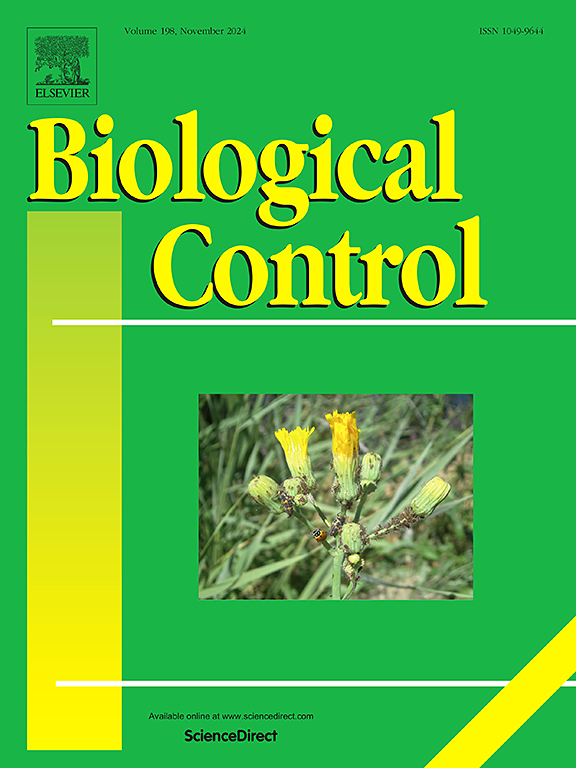The biological control agent for bacterial canker of kiwifruit, in Aureo® Gold, is a strain of Aureobasidium pullulans identifiable by novel SCAR marker primers
IF 3.7
2区 农林科学
Q2 BIOTECHNOLOGY & APPLIED MICROBIOLOGY
引用次数: 0
Abstract
The yeast-like fungus strain CG163, also known as YBCA5, is the active ingredient in Aureo® Gold, a biological control agent sold for control of bacterial canker of kiwifruit caused by Pseudomonas syringae pv. actinidiae. Analysis of the whole genome sequence of CG163 as well as a multi locus sequence analysis based on the ITS, ELO, EF-1α and β-tubulin genes indicate that CG163 is a strain of Aureobasidium pullulans. None of the published PCR primers developed for the identification of other strains of A. pullulans led to an amplicon when using CG163 total DNA. Following PCR using 14 random amplified polymorphic DNA primers by themselves or in combination, we identified a Sequence Characterised Amplified Region (SCAR) marker specific to CG163. One set of primers designed on this SCAR marker gave a unique amplicon only with CG163 and not with any of the 164 strains of A. pullulans tested. In addition, an in silico analysis revealed that none of the 75 strains of A. pullulans for which the whole genome sequence is available had the same sequence as either one of those primers. To prevent the detection of false negatives, we developed a duplex polymerase chain reaction (PCR) based on those primers and primers which amplify a segment of the ITS. The limit of detection of this duplex PCR assay was 1 pg. This assay can be used for quality control; however, for detection and quantification of CG163 we developed a quantitative polymerase chain reaction (qPCR) assay. Using this assay, we positively identified CG163 and followed its establishment on kiwifruit leaves for seven days post treatment with Aureo Gold. Therefore, the primers designed in this project can be used to study the establishment and colonisation of plant tissues by CG163 and allow the development of a robust set of recommendations on how and when to best use Aureo Gold.
Aureo®Gold中猕猴桃细菌性溃疡病的生物防治剂是一种可通过新型SCAR标记引物识别的金黄色葡萄球菌(Aureobasidium pululans)
酵母样真菌菌株CG163,也被称为YBCA5,是Aureo®Gold的活性成分,Aureo®Gold是一种生物防治剂,用于防治由丁香假单胞菌引起的猕猴桃细菌性溃疡病。actinidiae。对CG163的全基因组序列分析以及基于ITS、ELO、EF-1α和β-微管蛋白基因的多位点序列分析表明,CG163是一株pululans Aureobasidium。已发表的用于鉴定其他普鲁兰单胞菌菌株的PCR引物在使用CG163总DNA时均未产生扩增子。利用14个随机扩增的多态性DNA引物单独或联合进行PCR,我们鉴定出了CG163特异性的序列特征扩增区(SCAR)标记。在SCAR标记上设计的一组引物只对CG163有独特的扩增子,而对164株普鲁兰单胞菌没有扩增子。此外,一项计算机分析显示,75株普鲁兰芽孢杆菌中没有一株的全基因组序列与这两种引物中的任何一种序列相同。为了防止假阴性的检测,我们基于这些引物和扩增ITS片段的引物开发了双聚合酶链反应(PCR)。本双链PCR检测限为1 pg,可用于质量控制;然而,为了检测和定量CG163,我们开发了一种定量聚合酶链反应(qPCR)方法。利用该方法,我们对CG163进行了鉴定,并对其在猕猴桃叶片上的建立进行了7天的跟踪研究。因此,本项目设计的引物可用于研究CG163在植物组织中的建立和定植,并为如何以及何时最好地使用Aureo Gold提供一套可靠的建议。
本文章由计算机程序翻译,如有差异,请以英文原文为准。
求助全文
约1分钟内获得全文
求助全文
来源期刊

Biological Control
生物-昆虫学
CiteScore
7.40
自引率
7.10%
发文量
220
审稿时长
63 days
期刊介绍:
Biological control is an environmentally sound and effective means of reducing or mitigating pests and pest effects through the use of natural enemies. The aim of Biological Control is to promote this science and technology through publication of original research articles and reviews of research and theory. The journal devotes a section to reports on biotechnologies dealing with the elucidation and use of genes or gene products for the enhancement of biological control agents.
The journal encompasses biological control of viral, microbial, nematode, insect, mite, weed, and vertebrate pests in agriculture, aquatic, forest, natural resource, stored product, and urban environments. Biological control of arthropod pests of human and domestic animals is also included. Ecological, molecular, and biotechnological approaches to the understanding of biological control are welcome.
 求助内容:
求助内容: 应助结果提醒方式:
应助结果提醒方式:


